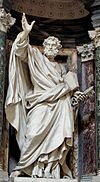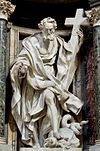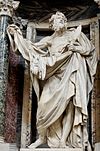Sotirianity: Difference between revisions
No edit summary |
|||
| Line 17: | Line 17: | ||
| [[File:Petrus_San_Giovanni_in_Laterano_2006-09-07.jpg|100px]] || {{wp|Saint Peter|Simon Peter}} || [[Solaria]] || Brother of {{wp|Andrew the Apostle|Andrew}}. Considered the leader of the Apostles and the head of the early Church; traditionally said to have been martyred head downwards in Solaria in the between 64-68. | | [[File:Petrus_San_Giovanni_in_Laterano_2006-09-07.jpg|100px]] || {{wp|Saint Peter|Simon Peter}} || [[Solaria]] || Brother of {{wp|Andrew the Apostle|Andrew}}. Considered the leader of the Apostles and the head of the early Church; traditionally said to have been martyred head downwards in Solaria in the between 64-68. | ||
|- | |- | ||
| [[File:Jacobus_Major_San_Giovanni_in_Laterano_2006-09-07.jpg|100px]] || {{wp|James the Great}} || [[Adunis]] || Son of {{wp|Zebedee}}, brother of {{wp|John the Apostle|John}}, leader of the Church in Adunis. Martyred by decapitation as is recorded in the {{wp|Acts of the Apostles}}. | | [[File:Jacobus_Major_San_Giovanni_in_Laterano_2006-09-07.jpg|100px]] || {{wp|James the Great}} || [[Adunis]], [[Santiago Réquiescia]] || Son of {{wp|Zebedee}}, brother of {{wp|John the Apostle|John}}, leader of the Church in Adunis. Martyred by decapitation as is recorded in the {{wp|Acts of the Apostles}}. According to tradition, his remains are buried in [[Paretia]] at the city of [[Santiago Réquiescia]], [[Vicisa]]. | ||
|- | |- | ||
| [[File:Johannes_San_Giovanni_in_Laterano_2006-09-07.jpg|100px]] || {{wp|John the Apostle|John}} || !Ephesus?, [[Istros]] || Son of {{wp|Zebedee}}, brother of {{wp|James the Great|James}}. Traditionally held to be the writer of the {{wp|Gospel of John}}, three Epistles and the {{wp|Book of Revelation}}. Preached in Piraea before being exiled from the Empire to the city of Istros. The only Apostle traditionally held not to suffer martyrdom, on account of his presence during the {{wp|Crucifixion of Jesus}}. | | [[File:Johannes_San_Giovanni_in_Laterano_2006-09-07.jpg|100px]] || {{wp|John the Apostle|John}} || !Ephesus?, [[Istros]] || Son of {{wp|Zebedee}}, brother of {{wp|James the Great|James}}. Traditionally held to be the writer of the {{wp|Gospel of John}}, three Epistles and the {{wp|Book of Revelation}}. Preached in Piraea before being exiled from the Empire to the city of Istros. The only Apostle traditionally held not to suffer martyrdom, on account of his presence during the {{wp|Crucifixion of Jesus}}. | ||
Revision as of 19:24, 28 June 2021
This article is incomplete because it is pending further input from participants, or it is a work-in-progress by one author. Please comment on this article's talk page to share your input, comments and questions. Note: To contribute to this article, you may need to seek help from the author(s) of this page. |
Sotirianity is a monotheistic religion based on the teachings of Jesus Sotiras, who is considered the Son of God and the religion's chief prophet. It is the most practiced religion in the world, and emerged from Atudism during and after the life of Jesus, around two millennia ago. Its practice varies considerably between its different denominations, of which there are many.
Etymology
"Sotirianity" is based on the word "Sotiras", which is the epithet attached to Jesus, coming from the Ancient Piraean σωτήρ ("soter") and meaning "saviour", in recognition of the belief that Jesus Sotiras redeemed humanity by his death.
History
Sotirianity was and is.
The Twelve Apostles
Of Sotirias' followers, the principal there were a group of twelve Apostles, also called the "Twelve", who were tasked with spreading the Gospel to all nations. Traditional branches of Sotirianity hold them to be the authorities of the early Church from which Bishops and priests are descended from, forming a continuity with the earliest Church called Apostolic sucsession. Peter was held to be their principal leader, but it is disputed whehter or not his successors deserve more than mere symbolic pride of place. After the Amednist reaction, Amendist scholars tend to lessen their distinction from the other elders of the early Church, and downplay the authority of Peter's successors. One of the original twelve, Judas Iscariot, betrayed Sotirias and committed suicide, but was soon replaced in his office by Matthias. In addition to the Twelve, a thirteenth apostle, Paul, was an important missionary in the early Church who was the first apostle to really journey to Euclea, branching out from the Atudite community towards the other. Much of the details surrounding the early church are hard to verify historically, so much of the details about the apostles outside of the Holy Scriptures falls to Sacred tradition, recorded in the table below.
| Image | Apostle | Apostolic Sees | Notes |
|---|---|---|---|
 |
Simon Peter | Solaria | Brother of Andrew. Considered the leader of the Apostles and the head of the early Church; traditionally said to have been martyred head downwards in Solaria in the between 64-68. |
 |
James the Great | Adunis, Santiago Réquiescia | Son of Zebedee, brother of John, leader of the Church in Adunis. Martyred by decapitation as is recorded in the Acts of the Apostles. According to tradition, his remains are buried in Paretia at the city of Santiago Réquiescia, Vicisa. |
 |
John | !Ephesus?, Istros | Son of Zebedee, brother of James. Traditionally held to be the writer of the Gospel of John, three Epistles and the Book of Revelation. Preached in Piraea before being exiled from the Empire to the city of Istros. The only Apostle traditionally held not to suffer martyrdom, on account of his presence during the Crucifixion of Jesus. |
 |
Andrew | Arciluco | Brother of Peter, also called the First-Called, traditionally held to have preached in Piraea and Amathia. Held to have been martyred on a crux decussata. |
 |
Philip | ? | Evangelized all throughout the cities of modern Tsabara, and later martyred by crucifixion. |
 |
Bartholomew | Qufeira? Balad Kafin? | Traditionally identified as Nathaniel in the Fourth Gospel. Evangelized and in northern Zorasan, was martyred by being flayed alive. |
 |
Matthew | ? | A former tax collector, held to be the writer of the Gospel of Matthew, which was targeted to the Atudite community he was preaching. Later journeyed to Etruria and was martyred by decapitation. |
 |
Thomas | ? | Travelled to Satria and founded Sotirian communities there. |
 |
James the Less | ? | Evangelized and martyred in Paretia by being beaten to death. |
 |
Jude Thaddeus | ? | Evangelized in modern Nise and Sohar. Beheaded with an axe. |
 |
Simon | ? | Evangelized in modern Behera. Martyred by being being sawn in half. |
 |
Matthias | ? | Selected by the Apostles to fill the place of Judas Iscariot. Evangelized in modern Gaullica, later martyred in Estmere. |
 |
Paul | Solaria, Montecara, many others | Not one of the original Twelve, he first persecuted Sotirians before later converting and becoming one. The first apostle to leave Coius to preach to the Euclean portions of the Solarian Empire, he was an instrumental figure in the early Church and an important writer of most of the books in the New Testaments. He came and preached to many of the cities throughout Piraea, Etruria, Emessa and even Montecara, establishing many Churches on multiple journeys. Was later taken to Solaria and martyred in close proximity with Peter. |
Denominations
There are many varieties of Sotirianity, typically divided organisationally, and each claiming to be the true successor to the original church established to uphold Sotirianity. One of the oldest, and the largest, is the Solarian Catholic Church, led by the Pope. Other main divisions of the religion include the Episemialist Church, which does not have a central authority like Catholicism, thus being divided into Patriarchates, foremost among which is the Ecumenical Patriarchate of Arciluco. Amendism is a name for those churches which seceded from the Catholics in the mid second millennium CE, seeking to amend their doctrine and practices; there are many Amendist churches of wide variance, including the Church of Azmara and the Church of Caldia. There is also the Brethren Church, mainly active in Satucin.